A fan’s guide – the club from early doors to today
Austria’s most popular and most titled club, based in the Hütteldorf district of west Vienna, Rapid have been trailing in Salzburg’s shadow for many years. Rapid’s current title drought dates back to 2008.
Despite this lack of recent success, Rapid have invested in the future, with a €50 million stadium, the Allianz, built on the site of their former Gerhard-Hanappi-Stadion. Work was completed for the 2016-17 season, and a curtain-raising friendly with Chelsea.
For a brief time, the Grün-Weißen again had one up on their eternal rivals, whose own stadium rebuilding wasn’t completed until 2018. Rapid have had the better of the 300-plus matches over Austria Vienna in the Wiener Derby, Europe’s most enduring cross-city clash after Glasgow’s.







Founded in 1898 as the First Vienna Workers’ Football Club by employees at a local hat factory, the club quickly changed to their now familiar name after a Rapid in Berlin. Rapid have always had a workmanlike approach to the game, typified by tank-like striker Pepi Uridil of the World War I era.
Although the social divisions hardly apply today, Austria enjoyed bourgeois support, Rapid working-class, typified by the Rapidviertelstunde, a rhythmic hand-clapping by fans to push their team to victory over the last 15 minutes, however doomed the situation.
Rapid won the first derby in 1911, the year that pre-war star Franz ‘Bimbo’ Binder was born. Scorer of more goals than games played in green and white, Bender was also later coach at Rapid. Binder’s 1,000-goal career crossed paths with other prolific players of the pre-war era such as Matthias Kaburek, Ferdinand Wesely and Franz Weselik. Rapid won a dozen titles, even the German one after the Anschluss that merged Austria and Nazi Germany.
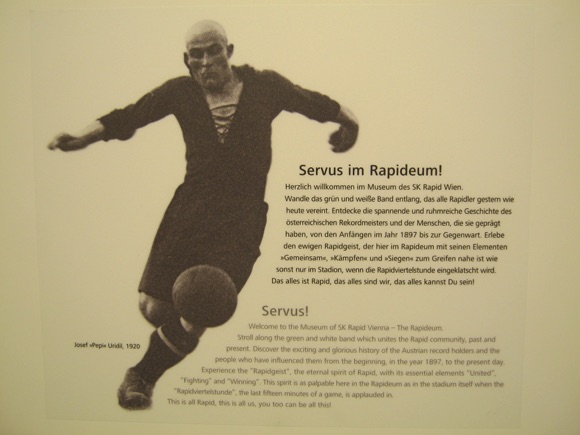





Rapid continuted to dominate the Austrian game after the war, with Robert Dienst another striker to notch up more goals than appearances. Driving the team was Gerhard Hanappi, later an architect and planner of the club’s stadium that now bears his name.
Ironically, the club’s most fallow period coincided with the arrival of their most celebrated player, Hans Krankl, who returned to Rapid after a spell at Barcelona to lead Rapid in the 1980s.
After a controversial play-off victory over Celtic, Rapid reached the final of the Cup Winners’ Cup in 1985, losing to Everton. They repeated the run, and the result, a defeat to Paris Saint-Germain, a decade later.






Since then, Rapid have only won the title twice, most recently in 2008 with the combination of young striker Erwin Hoffer and attacking midfielder Steffen Hofmann, still the club’s figurehead and captain.
Despite the promise of playing in a new stadium – and the 2-0 win over Chelsea to open it – Rapid otherwise had a season to forget in 2016-17. Qualification for the Europa League tempered another disappointing campaign in 2017-18.
Occasional highlights in European group stages – single wins over Rangers, Genk and Spartak Moscow – was bookended by an embarrassing defeat to Vaduz of Liechtenstein to bar the way to progress in the Conference League in 2022. There probably hasn’t been a worse time to be a Rapid fan in over a century.







Stadium Guide
The field of dreams – and the stands around it





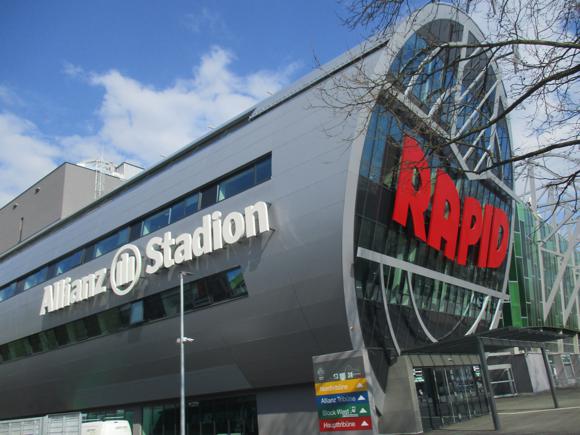
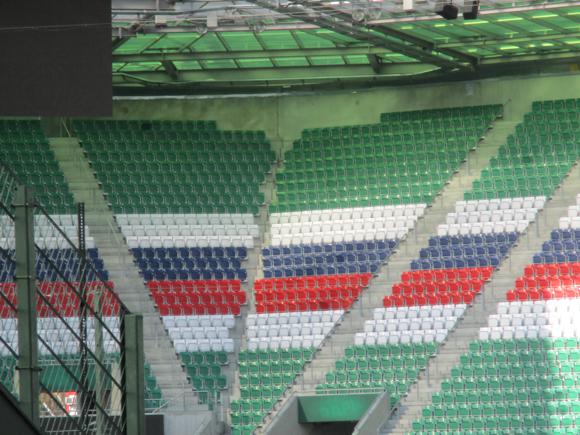

Opened on the eve of the 2016-17 season, the €54 million Allianz Stadion was built on the site of its predecessor, the Gerhard-Hanappi-Stadion. Its capacity of 28,600 was achieved in such a cramped, residential space by planners rotating the stadium 90 degrees, so that the legendary Westtribüne is now on the south side, lining Keißlergasse. It keeps faith with history, if not geography, by being called Block West (sectors 15-18).
Visiting fans are not only allocated Gästesektor 6-7 in one corner of the Nordtribüne, but supporters’ buses access the ground via a fenced-off entrance that leads to an underground passage on Linzer Straße.
Both home and away ends having standing terraces, removed for European fixtures, bringing the capacity down to 24,000, and the Gästesektor from 2,500 for domestic games to 1,800.


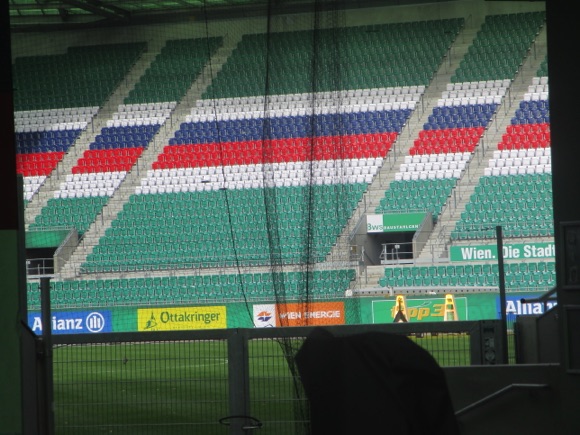


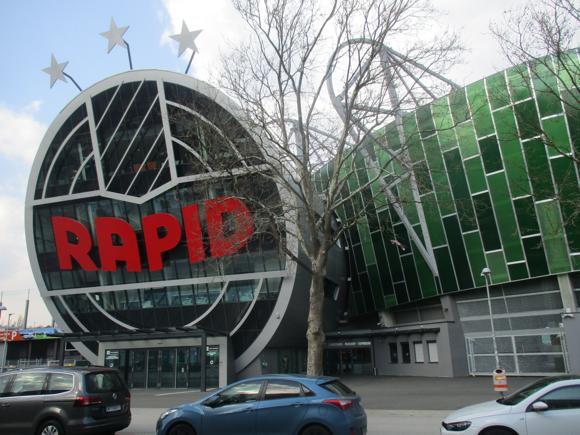


With echoes of Dortmund’s Signal Iduna Park, a futuristic cylinder-shaped construction displays the club name ‘RAPID’ in huge red letters – this is the entrance to the main Haupttribüne, aka Röhre (‘tube’). Alongside is the club shop, ticket office and imaginative club museum, Rapideum, pretty much the first thing you come to as you approach from Hütteldorf station. Like the Rapideum, the statue of Dionys Schönecker, pre-war player and coach (‘Father of the Rapid Spirit’), survived the transition from Gerhard-Hanappi-Stadion to Allianz.
Unveiled with a derby game against Austria Vienna in 1977, Rapid’s previous home was named after its architect and key post-war player. The ground it replaced, where Hanappi had shone, was the Pfarrwiese, Rapid’s first proper ground after the club had played on various pitches around the west of the city. Opened in 1911, the year of the first Vienna derby, the Pfarrwiese in Hütteldorf originally held 4,000, rising to 20,000 during the Rapid’s glory days.
Modernisation proved impossible in such a tight, residential area, so Rapid had Hanappi plan the Weststadion, an all-seater of 19,000 capacity backdropped by the verdant slopes of the Wienerwald. It was named after Hanappi in 1980 following his early death from cancer.
getting there
Going to the stadium – tips and timings

To visit the Allianz Stadion, head to Hütteldorf, the terminus of the green U4 line. Take exit Keißlergasse, cross the road as you come out and veer right. This is also an S-Bahn and train station for regional and long-distance lines.
The stadium is to your left after a short walk along Keißlergasse.
getting in
Buying tickets – when, where, how and how much



The main ticket outlet is the FanCorner (Mon-Sat 10am-6pm, match days from 10am & 1hr after final whistle) tucked inside the FanShop beside the huge RAPID sign on the Keißlergasse side of the stadium – it’s just to the right as you enter. Tickets are also sold through the Rapid FanShop (Mon-Wed 9am-7pm, Thur-Fri 9am-8pm, Sat 9am-6pm, 5hr before kick-off on match-day Sun/hol) in the Stadion Center behind Stadion U-Bahn station. There are also sales online.
Match-day sales are from the windows next to the FanShop at the stadium, from 10am.
Prices are divided into four categories for two types of matches. For most league and domestic cup games, the best A-category seats are €40 in sectors 10-11 over the halfway line in the Allianz Tribüne, B-category in the corners (sectors 9 and 12 offering the best views) are €32, C-category (including sectors 4-5 behind the Nordtribüne goal) €25. Hard-core Rapid fans and visiting supporters pay €20 to stand in sectors 15-18 and 6-7 respectively. For top league games such as against Austria Vienna and Salzburg, prices increase by €3-€5.
There are reductions (Ermäsigt, ID required) for students up to 26, over-60s and under-19s of €4-€7 depending on category and match type. This doesn’t apply in the visiting sectors. Under-14s are charged €10-€20, €15 an average price, with no reductions in the home and away sectors. Sector 2 between the Haupt- and Nordtribüne has been designated as the Familiensektor, with €5 entrance for accompanied children.
what to buy
Shirts, kits, merchandise and gifts



The main Rapid Fanshop (Mon-Sat 10am-6pm, match days from 10am & 1hr after final whistle) is on Keißlergasse beside the RAPID sign. There’s a smaller branch (Mon-Wed 9am-7pm, Thur-Fri 9am-8pm, Sat 9am-6pm, 5hr before kick-off on match-day Sun/hol) at the Stadion Center behind Stadion U-Bahn station near the national stadium.
In stock are quality T-shirts (including ones showing the old stadium and the original workers’ team from 1898), sew-on patches (remember them?) with cute father-and-son designs, and several books, one a pictorial record of the Last Days of the Hanappi-Stadion, a real work of art.
Even the little souvenirs, cigarette lighters, ashtrays, shot glasses, are attractive and well made.
Museum & tours
Explore the club inside and out





Now accessed at the back of the FanShop, with the same opening hours, the Rapideum (€7, €5 reduced, €3 under-14s, tickets from FanCorner) is excellent. It makes imaginative use of its new wider space and wealth of material by a series of touchscreens and pull-out displays.
Under the theme of ‘Together, Battle, Win’, the museum goes through each era from the Zur Schmelz pub on Hugglgasse in the late 19th century to the present day. Special attention is given to pre-war player/coach Dionys Schönecker (note the fob watch) whose statue still stands outside, the old Pfarrwiese ground, Rapid during the Nazi era and the controversial game with Celtic in 1984.
Tickets can be combined with a 45-minute stadium tour (German-only) at €15, €12 reduced, €3 under-14s.
Where to Drink
Pre-match beers for fans and casual visitors




Although the stadium is all new, there’s still a deep sense of Rapid support in the bars around it. From Hütteldorf station, on the corner with Bahnhofstraße, the homely Gasthaus Peschta is an old locals’ bar with framed Rapid and Wiener Sport-Club line-ups from various eras.
Further down Keißlergasse, opposite the stadium by the club shop, the Stag’s Head is a comfortable restaurant-faux pub with its own Stag’s Head beer, plus proper Budweiser, Guinness and Kilkenny, a full menu and lunchtime specials. Live music might be an extra if you happen to be hanging around after an evening game.



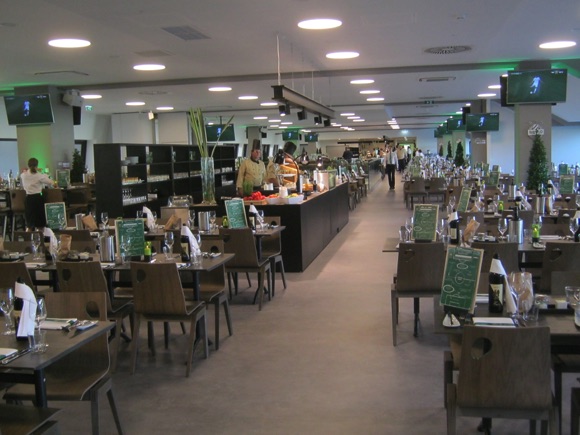



Further along Keißlergasse past the stadium, the Café Corner is a small but authentic Rapid fans’ bar, while the timeless Stüberl zum Weststadion (Deutschordenstraße 16) has plastered its traditional wooden interior in Rapid line-ups season-by-season.
At the stadium, payment for half-litres of Ottakringer lager and sausages is by smartcard, available from vendors around the ground. Opened four months after the stadium itself, and operating during the week, the Rekordmeister Bar (Mon-Fri 11am-5pm, special entry on match days) is set on the third floor of the Haupttribüne, accessed beneath the big RAPID sign. Done out in Rapid green with black-and-white archive photo murals, it offers schnitzels, salads, burgers and snacks, with weekday lunch deals.








